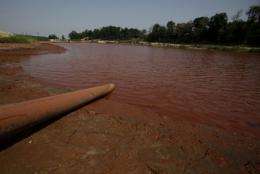A picture taken in July 2011 shows a red sludge storage facility near Kolontar, 160 km west of Budapest. A year after Hungary's worst chemicals spill released vast amounts of poisonous red mud, levels of toxic substances are lower than feared but still above average, Greenpeace said.
A year after Hungary's worst chemicals spill released vast amounts of poisonous red mud, levels of toxic substances are lower than feared but still above average, Greenpeace said on Wednesday.
"All in all the levels of toxic contamination, particularly in maize and in the soil, are lower than feared," said Herwig Schuster from the environmental pressure group's central and eastern European office in Vienna.
"A lengthy and expensive clean-up will be needed in order to turn the rivers back into a functioning ecosysystem."
In October 2010 a breach in the retaining walls of a reservoir at an alumina plant in Ajka in western Hungary sent 1.1 million cubic metres (38.8 million cubic feet) of toxic red mud cascading into surrounding villages.
Ten people were killed as the devastation spread across an area of 40 square kilometers (more than 15 square miles).
According to its tests, aluminium levels are now almost seven times higher than the amount dangerous to some fish, while arsenic and chrome levels in soil were "slightly" higher than permitted in Austria, Greenpeace said.
Tests on maize showed increased amounts of lead, but below the European Union maximum. Greenpeace said it had no information on the state of ground water in the area.
(c) 2011 AFP
























